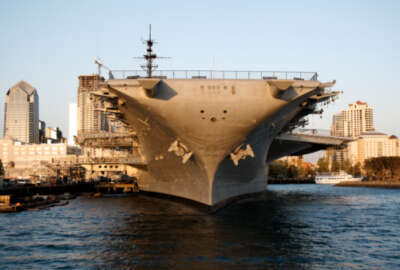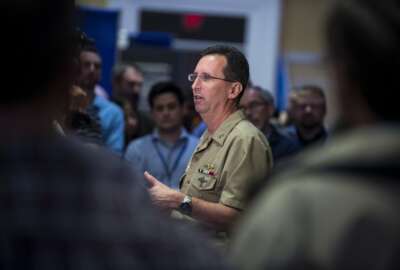
Navy’s weakness lies in delivering innovative products fast, CNO says
The Navy says it can handle any fight, but it's processes for bringing products to sailors is slow.
The Navy’s top officials say the service is back on track when it comes to rebuilding readiness, but moving forward the Navy still needs to close some vulnerability gaps now that it is focusing on near-peer competitors like China and Russia.
Chief of Naval Operations Adm. John Richardson doesn’t think there is any particular adversarial technology that will challenge the force right now. However, he does think the Navy is shooting itself in the foot when it comes to its processes for fostering inventive thinking.
“Our system right now is slowing us down in terms of getting products out,” Richardson said Monday during an event at the Brookings Institution in Washington. “Potentially a strategic Achilles heel is our ability to move with urgency to get these systems from the laboratory out into the fleet. This is just a problem where we have to have a bias for getting things done, rather than a bias for studying them yet again before we get them done.”
That concern is influenced by the National Defense Strategy, which puts Russia and China at the top of the threat landscape. The United States feels it needs to speed up its acquisition and business processes in order to keep its technological advantage over the rapidly developing countries.
Richardson put part of the blame for the slow rollouts on the budget uncertainty that continues to plague the government.
“There is something attractive to a five-year plan that’s laid out and funded,” Richardson said to chuckles from the audience. “I don’t think you necessarily need to change government — we do five year plans, five-year defense plans. One of my favorite places to visit is Singapore. You just see the fruits of a plan where you have a plan, you commit to it and you fund it. I think we can do that particularly in respect to delivery of capability and maintain that kind of great internal tension that’s built into our constitution with the three branches of our government.”
The Navy is already using some fairly new tactics to bring in new ideas and push products out quickly to sailors.
Earlier this month, the Navy established another consortium to reach out to small and nontraditional companies that are thinking outside the box.
The new surface warfare consortium, which the Navy announced on Jan. 16, will use “innovative technological solutions to address current and future security threats in the surface and maritime environment,” the Navy said in its draft request for proposals.
Consortia take advantage of other transaction authorities (OTAs) recently given to the Defense Department by Congress.
The agreements permit DoD to fund research and prototyping from nontraditional defense companies or from a collaboration between nontraditional and traditional defense companies.
Last summer, the Navy gave OTA authority with a $500 million ceiling to all five Navy systems commands.
“OTAs, I think, are a tool. They’re not the perfect tool for every job, just like the hammer isn’t the perfect job for a screw, but if you don’t have a hammer, some jobs you can’t do,” James Geurts, Navy Assistant Secretary for Research, Development and Acquisition, told Federal News Network last September. “I look at OTAs as one of many tools we need to perfect. Prize challenges are great tools, cooperative research and development agreements are great tools, small business innovative research contracts are great tools. They really train and hold the workforce accountable for being knowledgeable and using all those tools in the appropriate manner.”
OTAs are the hottest thing in the defense world right now. DoD spent $4.2 billion on OTA agreements in 2018, an increase of nearly $2 billion from 2017, according to a new analysis by Bloomberg Government.
The Navy is also switching up its strategy to deliver goods faster. The latest version of the Design for Maintaining Maritime Superiority, released on Dec. 17, overhauls the way the Navy approaches its educational institutions. The educational system will now put more emphasis on research, collaborating with industry and intertwining real-world experience to create a more agile learning environment.
The Navy will set up two major hubs, which are basically centers of excellence. One will be located on the East Coast and another on the West, and will focus on concept development and capability development, respectively.
“Now that we’ve got this great power competition as a unifying theme we can start to get this learning engine really going,” Richardson told Federal News Network after the Navy released the strategy. “The gears are starting to mesh as we think about how we are going to confront this competitive environment.”
Copyright © 2024 Federal News Network. All rights reserved. This website is not intended for users located within the European Economic Area.
Scott Maucione is a defense reporter for Federal News Network and reports on human capital, workforce and the Defense Department at-large.
Follow @smaucioneWFED





